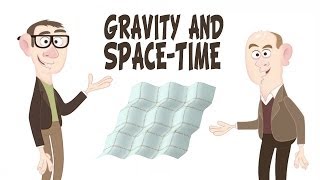(单词翻译:单击)
Gravity. It controls the universe.
引力,它控制着宇宙。
Everything attracts everything else. Ouch! Including you. Ow!
万物互相吸引。哎哟!包括你,哎哟!
In this final lesson, we'll explore what gravity means for space-time, or rather what space-time means for gravity.
在这最后一课里,我们将探寻引力对于时空意味着什么,更准确地说,是时空对于引力意味着什么。
Until now, we've been dealing with things moving at constant speeds, with straight world lines in space-time.
目前为止,我们已经处理过了匀速运动的物体,它们的世界线是直线。
But once you add gravity, if you measure a speed at one moment, then again a bit later, the speed may have changed.
然而一旦你加入引力,如果你在某一刻测量某物体的速度,稍后再次测量,速度可能会有所变化。
In other words, as I discovered, gravity causes acceleration,
换句话说,我发现引力造成加速,
so we need the world line to look different from one moment to the next.
因此从某一刻至下一刻,世界线需要看起来有所变化。
As we saw in the last lesson,
如我们上一节课所见,
the correct way to tilt an object's world line is using a Lorentz transformation: Einstein's stretch and squash trick.
倾斜一个物体的世界线的正确方法是使用洛伦兹变换:爱因斯坦的拉伸和压缩戏法。
So, to map out what gravity is doing to Tom's motion,
为了弄清引力如何影响汤姆的运动,
we need to create a whole load of little patches of space-time, each transformed by different amounts.
我们需要制造一大堆小片的时空补丁,对每一小片补丁做不同程度的变换。
So that my world line is at a different angle in each one.
使得我的世界线在每一小片里都有不同的角度。
And then, we're ready to stitch everything together.
随后,我们就可以把所有的小片补丁缝到一起。
We assemble a cozy quilt of space-time where world lines look curved.
我们组成了一条舒适的时空被子,其中的世界线看起来是弯曲的。
Where the world lines join, the objects collide.
当世界线相交时,物体发生了碰撞。
By making these connections between the patches, a curvature gets built into space-time itself.
随着我们将这些补丁连接起来,时空本身产生了弯曲。
But Einstein's true genius was to describe precisely how each patch
但是爱因斯坦真正天才的地方在于,他精确描述了每块补丁,
is stretched and squashed according to nearby mass and energy.
是如何根据其附近的质量和能量而拉伸和压缩的。
The mere presence of stuff curves the space-time, and curving space-time moves the stuff around.
物体的存在就能弯曲时空,而弯曲的时空又会移动物体。
This is gravity, according to Einstein.
爱因斯坦认为,这就是引力。

Previously, Isaac Newton had explained gravity using the ideas of force and acceleration,
早先,艾萨克·牛顿使用力和加速度的概念来解释引力,
without any wibbily wobbly space-time, and that did pretty well.
并不需要扭曲的时空解释的效果也不错。
But Einstein's theory does just slightly better at predicting,
但是爱因斯坦的理论在预测物理现象时更好一点点,
for example, the orbit of Mercury around the Sun, or the way that light rays are deflected by massive objects.
比如在预测水星绕太阳的轨道时或者光如何被大质量物体偏折。
More importantly, Einstein's theory predicts things
更重要的是,爱因斯坦的理论预测出了
that simply don't exist in older theories where space, time and gravity were separate.
在时间、空间、引力分离的旧理论中不存在的现象。
The stitching can leave wrinkles in the space-time material.
缝制的过程可以造成时空的褶皱。
These are called gravitational waves,
这些褶皱被称为引力波,
which should be detectable as tiny, repetitive, subtle squashes and stretches in space.
这应该是可以探测到的它体现为空间里极小的、重复的、微妙的伸缩。
So we're building experiments to check if they are there.
我们正在建造实验来验证其的存在。
In the meantime, indirect evidence,
与此同时,有间接证据,
most recently in the polarization patterns of light left over from the Big Bang, strongly suggest that they are.
强烈地暗示了它们的存在,最近的一个间接证据是大爆炸余晖中的偏振模式。
But despite Einstein's successes, when too much stuff gets concentrated in too small a space,
虽然爱因斯坦的理论很成功,然而当很多东西被集中到一个很小的空间里,
like in a black hole, the curvature of space-time becomes so large, that his equations collapse.
比如一个黑洞,此时时空的曲率是如此之大,以至于爱因斯坦的公式崩溃了。
We need a new picture of space-time that incorporates quantum mechanics to unlock the secret at the heart of black holes.
我们需要一个加入了量子力学的新的时空理论,这样才能解开黑洞中心的秘密。
Which means there's plenty more to be discovered about space, time, and space-time in the future.
这意味着在将来还有很多关于空间、时间和时空的东西有待发现。


